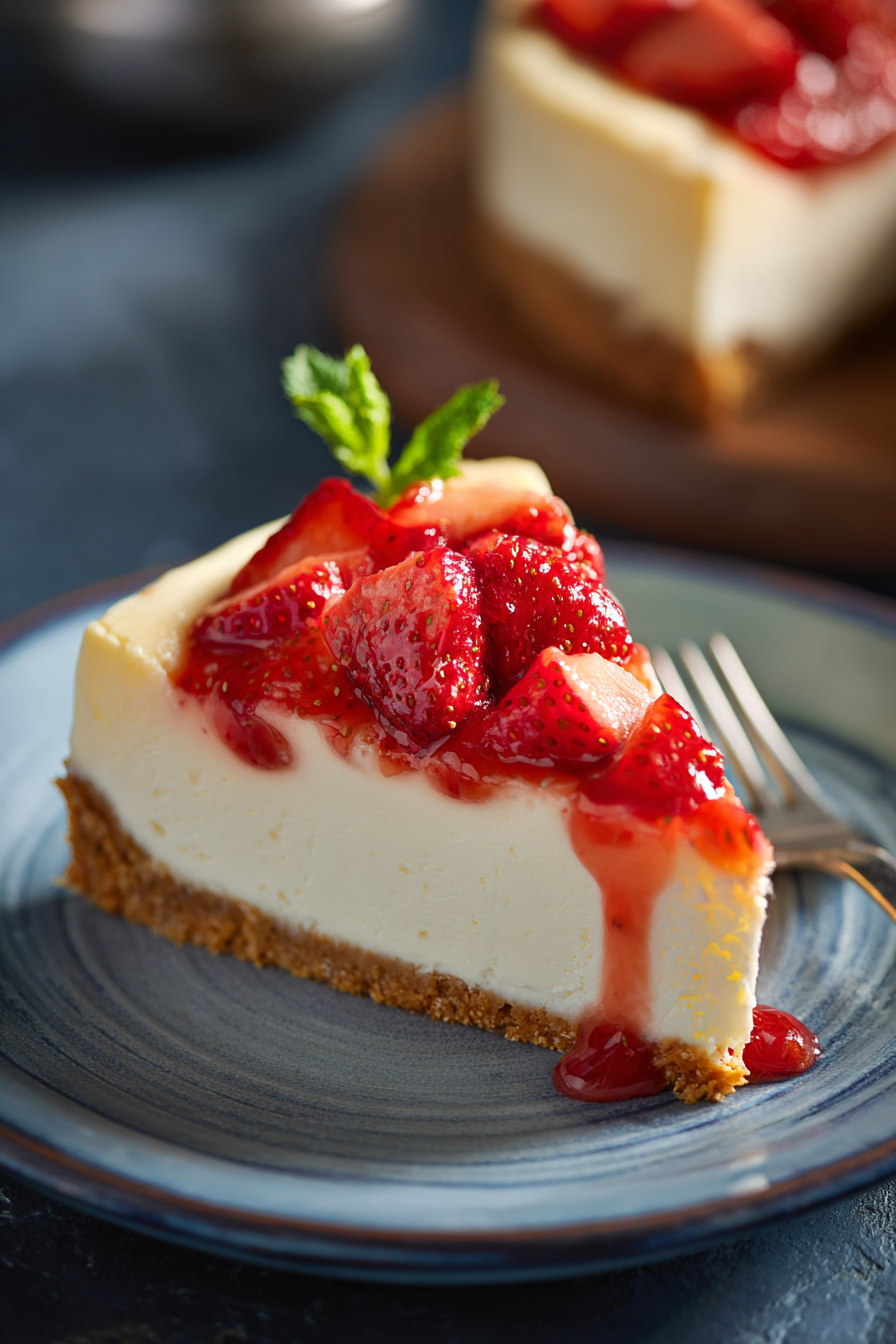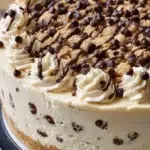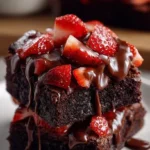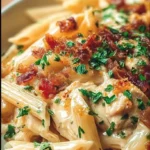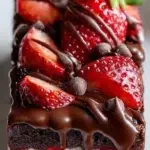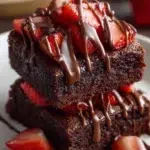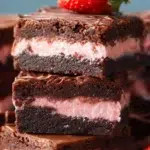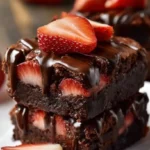Choosing Quality Ingredients for a Perfect New York Cheesecake
Why Ingredient Quality Makes a Big Difference
When it comes to a flawless New York cheesecake recipe, quality matters more than you think. While cheesecake might seem like a simple dessert, it’s the combination of premium ingredients that elevates it from basic to bakery-style. Skimping on one or two components—especially the cream cheese or eggs—can drastically alter your results.
High-fat content in dairy gives your cheesecake that signature silky texture. Low-fat substitutes might seem like a healthy option, but they often lead to grainy or runny texture. The better the base, the smoother your filling.
Table of Contents
The Must-Have Ingredients (And Why They Matter)
Here’s a breakdown of what you absolutely need and how each ingredient plays its role:
| Ingredient | Role in Recipe | Pro Tip |
|---|---|---|
| Full-fat cream cheese | Main body of the cheesecake, ultra creamy | Use room temperature blocks |
| Granulated sugar | Sweetness and structure | Don’t overmix after adding sugar |
| Sour cream | Adds tang and richness | Use full-fat for the best results |
| Eggs | Binds everything, gives it custard-like set | Add one at a time, mixing slowly |
| Vanilla extract | Boosts depth and aroma | Use pure vanilla, not imitation |
| Graham crackers | Crust foundation | Crush finely for even texture |
| Unsalted butter | Binds the crust | Melt completely before mixing |
Don’t miss our what is butter cake made of to explore more about butter-based desserts.
Optional Add-Ins to Customize Flavor
Once you’ve nailed the basics, feel free to experiment with gentle twists:
- Lemon zest or juice – for a slight citrus lift
- Almond extract – gives a nutty undertone
- Crushed cookies in the crust – like Biscoff or Oreos for variation
(Discover great ideas like our biscoff cookie butter cinnamon rolls.)
These optional upgrades won’t overpower the classic taste but can add your signature flair.
What to Avoid Using
Some ingredients may seem tempting but can cause disaster:
- Low-fat cream cheese – too watery
- Powdered sugar – alters texture and sweetness balance
- Egg substitutes – may not set properly
- Whipped cream cheese – hard to measure and mix evenly
This isn’t the time for shortcuts. Stick to the tried-and-true ingredients for that iconic New York cheesecake texture and flavor.
Ingredient Sourcing Tips
If you want to take your cheesecake to the next level:
- Buy local or organic dairy when possible for fresher taste
- For the freshest flavor and texture, crush whole graham crackers yourself rather than using store-bought crumbs.
- Avoid generic cream cheese brands—go with Philadelphia or something equally rich
Looking for inspiration? Try our what is a brookie made of to blend brownie and cookie textures into one sweet treat!
Mastering the Perfect Graham Cracker Crust
Why the Crust Sets the Stage
Before you dive into that rich, creamy filling, remember this: the crust is more than just a base—it’s your cheesecake’s foundation. A soggy or underbaked crust can ruin the overall texture, while a crisp, buttery graham cracker crust gives your New York cheesecake recipe a delightful contrast to the smooth center.
Crafting the perfect crust isn’t hard, but it does require a few key techniques.
The Best Graham Crackers to Use
Your crust’s flavor depends largely on your cracker choice. Classic honey graham crackers work beautifully for a mildly sweet, nutty base. Chocolate grahams can be used for a deeper, more indulgent twist—especially if you’re making a chocolate swirl variation.
| Graham Cracker Type | Flavor Profile | Best Use Case |
|---|---|---|
| Honey graham | Mild, buttery, classic | Traditional NY cheesecake |
| Cinnamon graham | Warm spice, sweet | Fall/holiday cheesecakes |
| Chocolate graham | Rich, dessert-like | Great with chocolate swirl |
| Gluten-free graham | Slightly grainy | For gluten-sensitive eaters |
Don’t miss our what else can you do with a Ninja Creami for more dessert base inspiration.
How to Prep Your Crust Perfectly

Here’s how to achieve that crisp-but-not-dry crust every time:
- Crush the grahams finely – use a food processor or a rolling pin with a zip bag.
- Mix with melted unsalted butter – this binds the crumbs and adds richness.
- Add a pinch of sugar and salt – enhances flavor.
- Press firmly into a springform pan – use the bottom of a measuring cup for even compression.
- Bake it before adding the filling – 10 minutes at 325°F sets the crust and prevents sogginess.
Image Placement: Graham Crust Process
- Filename: graham-cracker-cheesecake-crust.jpg
- Alt Text: Graham cracker crust for New York cheesecake
- Caption: Prepare a golden graham crust to hold your rich cheesecake filling
- Description: Shows the base preparation step of this New York cheesecake recipe
- Placement: Right under this section
What Not to Do With Your Crust
Avoid these common mistakes:
- Using cold butter – makes crumbs clump unevenly
- Skipping prebaking – leads to soggy, undercooked base
- Using too little butter – causes a loose, sandy texture
- Overpacking the crust – can turn hard and tough to slice
Discover great ideas like our what is the difference between a butter cake and a pound cake to learn how other desserts handle base texture differently.
Can You Use a Different Crust?
Yes, but graham cracker is iconic for a reason. That said, these alternatives can work:
- Crushed Oreos – for a chocolate base
- Vanilla wafers – for a milder, buttery option
- Almond flour + butter – for a low-carb twist
Be mindful: alternative bases may need slightly different baking times.
Making the Creamiest Cheesecake Filling Ever
Why Texture Is Everything in Cheesecake
When you imagine a slice of classic New York cheesecake, what comes to mind? Thick, smooth, and velvety texture—right? That luxurious mouthfeel doesn’t just happen on its own. It’s the result of high-quality ingredients, proper mixing techniques, and a little patience.
In this section, you’ll learn how to nail that rich and creamy consistency every single time.
Step-by-Step: Mixing the Perfect Filling
Let’s break it down so your filling turns out flawless—never lumpy, never grainy:
- Soften your cream cheese completely
Allow it to rest at room temperature for at least 2 hours before mixing to ensure even blending. Cold cream cheese creates lumps that are hard to fix. - Beat cream cheese alone first
Using a stand mixer or hand mixer, beat it on medium speed for about 3 minutes until it’s ultra-smooth and fluffy. This step matters more than you think. - Add sugar slowly
Gradually add granulated sugar while mixing. Scrape the sides and bottom of the bowl regularly. - Mix in sour cream and vanilla extract
These add richness and depth of flavor. Keep mixing on low to avoid introducing air. - Add eggs one at a time
Crack eggs into a bowl first to prevent shell mishaps. Add each egg, mixing just until combined—overmixing leads to cracks. - Strain if needed
For an ultra-smooth batter, you can pour the finished filling through a fine mesh sieve before pouring it into the crust.
Check out what goes with spicy mayo if you’re looking for sweet-savory fusion ideas.
Expert Tips to Prevent Air Bubbles and Cracks
Air is your enemy in cheesecake filling. Here’s how to keep it smooth and crack-free:
- Use low mixing speeds after adding the eggs
- Tap the filled pan on the counter before baking to release air bubbles
- Avoid overmixing at all stages
- Bake in a water bath (more on that in Part 4)
Flavor Boosts for Your Cheesecake Filling
Looking to customize your cheesecake while keeping that classic New York charm? Try these delicious ideas:
| Flavor Add-In | How to Use | Best Pairing |
|---|---|---|
| Lemon zest | Add 1 tsp during final mix | Pairs well with berry toppings |
| Espresso powder | Add 1 tsp dissolved in warm cream | Great with chocolate swirl |
| Almond extract | Replace ¼ tsp of vanilla | Boosts nutty notes |
| Pumpkin puree & spice | Mix ½ cup + 1 tsp spice for fall twist | Try cinnamon graham crust |
Looking for inspiration? Try our chocolate-strawberry hi-hat cupcakes for a combo of rich and creamy with a fruity punch.
Troubleshooting Common Filling Mistakes
Even the best bakers mess up sometimes. Here’s how to fix or prevent issues:
| Problem | Likely Cause | Fix/Prevention |
|---|---|---|
| Lumpy filling | Cold cream cheese or skipped scraping | Beat longer before adding eggs |
| Cracks on top | Overbaking, overmixing, no water bath | Bake slower and use steam |
| Grainy texture | Low-fat ingredients or curdled batter | Stick to full-fat and mix gently |
| Sunken center | Underbaked or cooled too fast | Bake longer at lower temp |
Don’t miss our chocolate custard cake eggless recipe for another ultra-smooth dessert idea.
Baking Techniques – Water Bath & Timing for Crack-Free Perfection
Why New York Cheesecake Needs Gentle Heat
You’ve prepped the perfect crust and mixed the creamiest filling—but the baking process can still make or break your cheesecake. Baking this rich, custard-like dessert requires a low-and-slow approach. A sudden temperature shift or uneven heat distribution will lead to cracked tops or undercooked centers.
That’s why water baths (also known as bain-marie) are a must for this recipe.
What Is a Water Bath and Why Use One?
A water bath is a pan of hot water placed around your cheesecake during baking. It helps regulate the oven’s heat and creates a moist environment—reducing the risk of overbaking, curdling, or surface cracks.
Benefits of a water bath:
- Promotes even baking
- Prevents surface cracks
- Keeps texture ultra-smooth and creamy
- Adds steam to the oven for gentle cooking
Check out how long to cook meatloaf 375 perfect guide for more temperature precision tips in baking and roasting.
How to Set Up a Water Bath (Step-by-Step)
- Wrap the springform pan in 2–3 layers of heavy-duty foil to prevent leaks.
- Place the wrapped pan inside a large roasting pan.
- Pour hot water into the roasting pan until it reaches halfway up the cheesecake pan’s sides.
- Carefully place in the preheated oven (325°F or 163°C).
Looking for more gentle baking ideas? Try our apple pie ice cream delight —a no-crack frozen dessert with similar finesse.
How Long to Bake Your New York Cheesecake
Baking times vary slightly by oven and pan type, but here’s a reliable guideline:
| Pan Size | Bake Time | How to Tell It’s Done |
|---|---|---|
| 9-inch springform | 60–70 minutes | Edges set, center has a slight jiggle |
| 8-inch round pan | 70–80 minutes | Edges set, longer bake due to smaller surface |
The cheesecake should look slightly puffed around the edges and still jiggle in the center like gelatin. This is exactly what you want.
Avoid the temptation to keep baking until it’s firm—it will finish setting as it cools.
Image Placement: Cheesecake in Water Bath
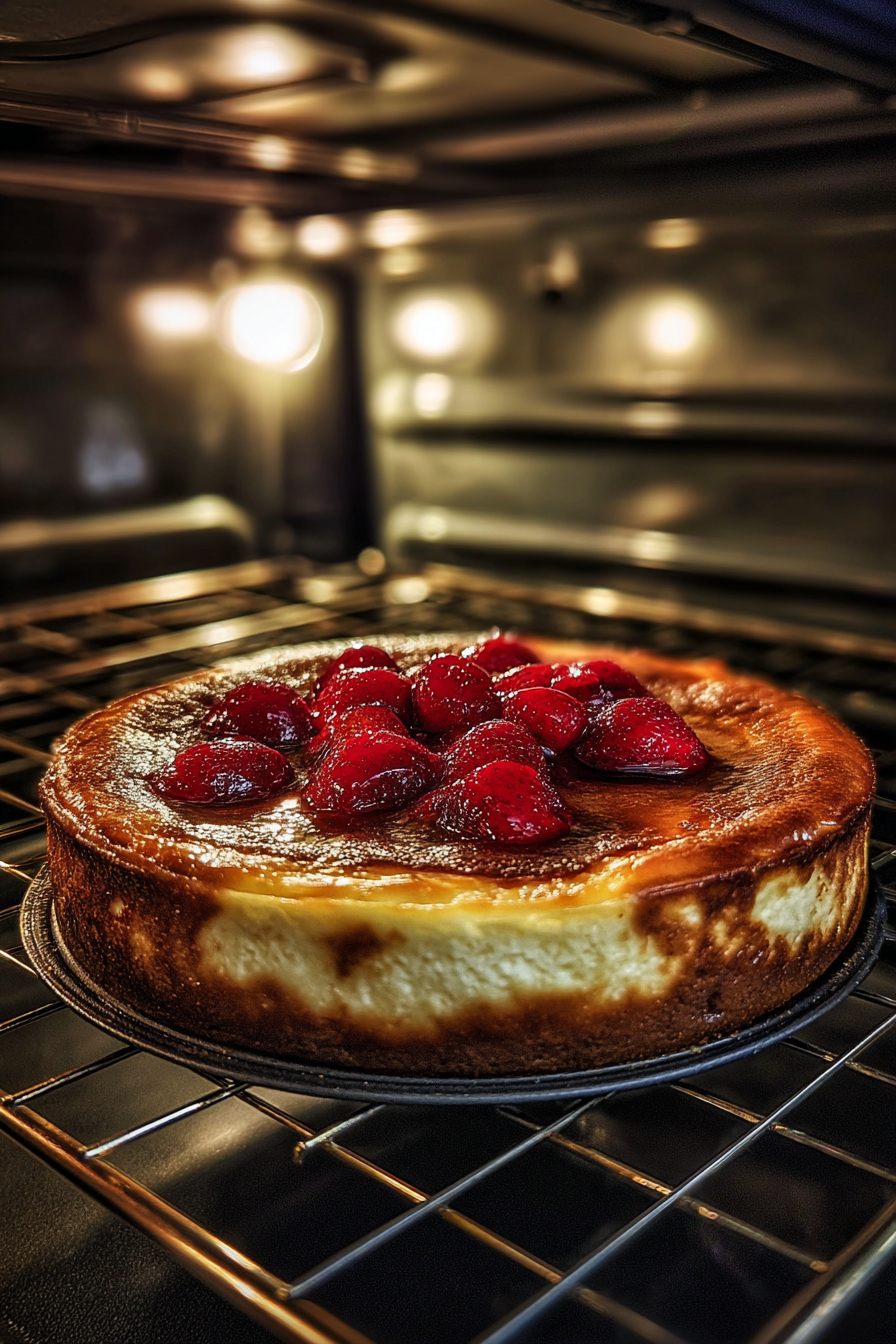
- Filename: baking-new-york-cheesecake-water-bath.jpg
- Alt Text: Baking New York cheesecake in water bath
- Caption: Prevent cracks by baking your cheesecake in a water bath
- Description: Step-by-step process of baking New York cheesecake with moisture-lock technique
- Placement: Just under this table or after the baking guide
Cooling Is Just as Important as Baking
This is where many bakers trip up. You can follow the entire New York cheesecake recipe flawlessly—only to have it crack from cooling too quickly.
Here’s how to avoid that:
- Turn off the oven once baking time ends.
- Leave the cheesecake in the oven with the door cracked open for 1 hour.
- Remove from oven and let sit at room temperature for another 30–60 minutes.
- Transfer to the fridge (uncovered) and chill for at least 4 hours—ideally overnight.
Sudden cooling leads to contraction and cracking. Gentle steps = perfect texture and appearance.
Don’t miss our meatloaf cooking temperatures 350°F vs 375°F explained for more baking strategies based on temperature balance.
Cooling, Chilling, and Slicing – Finishing Like a Pro
Why Patience After Baking Pays Off
You’ve baked your cheesecake to perfection using a water bath—but now comes the most overlooked step: cooling and chilling. Rushing through this part can ruin your cheesecake’s texture and appearance. Slow, steady cooling ensures no cracks, and proper chilling brings out the flavor and firmness.
Discover great ideas like our easiest peach galette – 15 minutes for quick bakes with less cooling time.
How to Cool a Cheesecake the Right Way
Here’s a foolproof post-bake cooling routine for your New York cheesecake:
- Cool in the oven first
After baking, turn the oven off, leave the door slightly open, and let the cheesecake rest inside for 1 hour. This step prevents thermal shock that causes cracking. - Move to the counter
Let it sit at room temperature for another 45–60 minutes. - Run a knife around the edge
Before chilling, gently slide a thin knife between the crust and pan to release it—this prevents splitting as it contracts. - Chill uncovered in the fridge
Refrigerate the cake in its springform pan for at least 4 hours. Overnight is best. Cover it loosely with foil or a cake dome after it’s cooled completely to avoid condensation buildup.
The Best Way to Slice Cheesecake Like a Bakery
Slicing your cheesecake can be the difference between “Pinterest-perfect” and “messy forkful.” Here’s the secret:
- Use a long, thin, sharp knife
Serrated knives or pie servers tear the cake—avoid those. - Warm the knife under hot water
Wipe it dry before each cut. Heat makes clean slicing easier. - Clean between each slice
Wipe the knife clean with a damp cloth after every cut. Yes, every. single. time. - Mark portions in advance
Use a ruler or string to evenly divide the top surface before making the first cut.
Don’t miss our should you flour chicken cutlets before breading for more precision kitchen tricks.
How Long Does Cheesecake Need to Chill?
Here’s a timeline breakdown for chilling:
| Chill Time | Result |
|---|---|
| 2–3 hours | Still too soft, difficult to slice |
| 4–6 hours | Firm enough for slicing, slightly soft |
| 8+ hours (overnight) | Perfect consistency, flavor developed |
Can You Freeze New York Cheesecake?
Absolutely. Freezing is a great option if you want to prep ahead.
- Cool and chill the cake fully first
- Wrap in plastic wrap + foil
- Store slices or whole cake in the freezer for up to 2 months
- Thaw overnight in the fridge—never on the counter
Looking for more make-ahead dessert inspiration? Try our peanut butter protein oatmeal cups which also freeze beautifully.
Topping Ideas – Classic & Creative Cheesecake Finishes
Do You Even Need a Topping for New York Cheesecake?
Truth be told—this New York cheesecake recipe is so rich and flavorful, it doesn’t need a topping at all. But if you want to dress it up for a special occasion or highlight a seasonal ingredient, toppings can elevate the visual appeal and flavor balance without stealing the show.
Think of toppings as the final touch—like sprinkles on a cupcake or a ribbon on a gift. Done right, they bring contrast and elegance without making the cake too sweet.
Check out peach cake for more fruity dessert inspiration that pairs beautifully with cheesecake bases.
Classic Cheesecake Topping Ideas (Never Fail Options)
These tried-and-true toppings keep the integrity of the cheesecake while adding just enough brightness or richness.
| Topping | Flavor Profile | How to Use |
|---|---|---|
| Fresh berries | Tart, juicy, sweet | Pile on top or serve on the side |
| Berry compote | Tangy and syrupy | Spoon over chilled slices |
| Sour cream glaze | Tangy and creamy | Spread on top before final chill |
| Whipped cream | Light and airy | Pipe or dollop before serving |
| Chocolate ganache | Decadent and rich | Pour while slightly warm over top |
| Lemon curd | Bright and tangy | Spread thin layer after cooling |
Looking for inspiration? Try our peach pie cruffins recipe to create a stone-fruit topping twist.
Creative & Unique Cheesecake Toppings (For Adventurous Bakers)
If you’re in the mood to impress or add a signature touch, these bold toppings will take your cheesecake to another level.
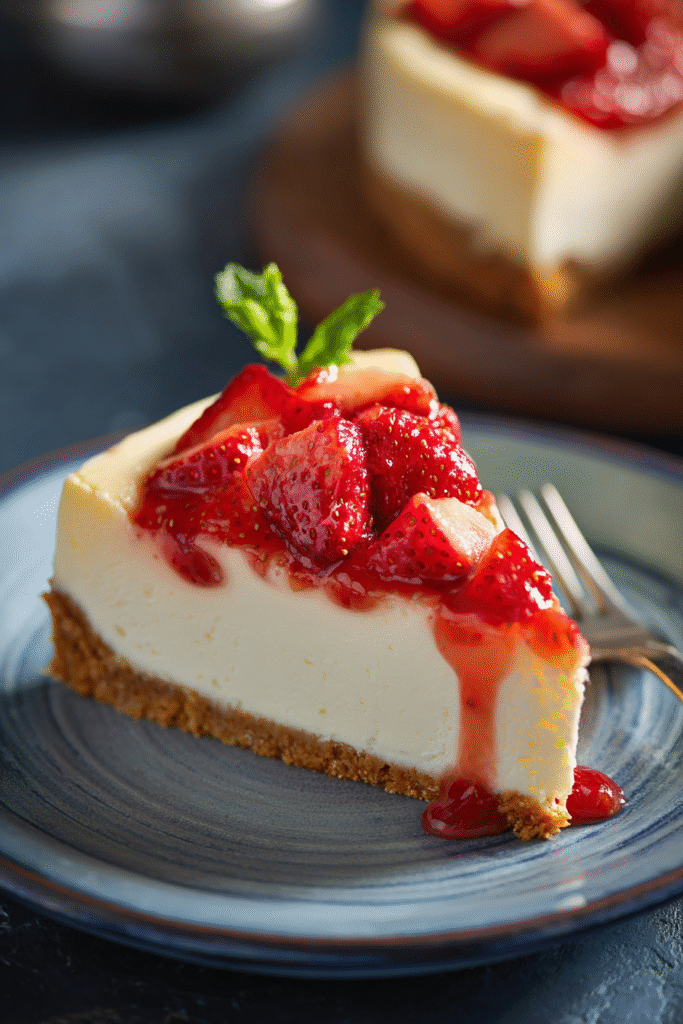
- Salted caramel drizzle – Adds sweet-salty depth
- Candied citrus peel – A zesty, elegant garnish
- Chopped roasted nuts – Adds crunch and flavor contrast
- Cookie crumbles or Biscoff spread – Fun and flavorful
- Toasted coconut flakes – For tropical cheesecake themes
- Espresso glaze – Perfect for coffee lovers
- Edible flowers – For a dramatic visual statement
Don’t miss our brazilian mounjaro drink recipe to pair your cheesecake with a show-stopping beverage.
When to Add Toppings
Timing is everything. Here’s when to apply your finishing touch based on the type of topping:
| Topping Type | When to Add |
|---|---|
| Fruit sauces | After the cheesecake is fully chilled |
| Ganache or curds | Once cooled to room temp |
| Whipped cream | Just before serving |
| Sour cream layer | Before the final 30-minute chill |
| Nuts & garnishes | After slicing, or before presentation |
Don’t miss our cotton candy cookies if you want to turn your topping into a sweet, colorful surprise.
Storing & Freezing Cheesecake the Right Way
How Long Does Cheesecake Stay Fresh in the Fridge?
Once your cheesecake has fully chilled and you’ve sliced into that perfect velvety center, you might wonder: how long will it last?
A properly stored New York cheesecake can keep its signature flavor and texture for up to 5 days in the fridge. But proper storage isn’t just tossing it on a plate and closing the door.
Here’s what to do:
| Storage Time | Method | Result |
|---|---|---|
| 1–2 days | Covered with plastic wrap | Soft and freshest texture |
| 3–5 days | Airtight container preferred | Still creamy, slightly firm |
| 5+ days | Transfer to freezer | Best option for long-term storage |
Don’t miss our how do you keep brownies soft and chewy for more dessert storage tricks.
How to Store Leftover Cheesecake Without Drying It Out
Moisture is key to preserving that bakery-soft bite. Follow these expert tips:
- Keep it covered – Use plastic wrap or aluminum foil pressed against the surface
- Use a cake dome or airtight container – Prevents fridge odors from altering flavor
- Separate slices with wax paper – Helps avoid sticking and smushing
- Store without toppings – Keep sauces or fruit separate to avoid sogginess
Learn more about food storage techniques in our how long can you wait to use sourdough discard.
Can You Freeze Cheesecake? Absolutely.
Freezing your New York cheesecake recipe is one of the best ways to save time—especially during the holidays.
Here’s how to do it right:
To freeze a whole cheesecake:
- Chill the cheesecake overnight
- Remove from springform pan (optional)
- Wrap in plastic wrap, then aluminum foil
- Transfer to a freezer-safe airtight container or a heavy-duty freezer bag to preserve freshness and prevent freezer burn.
To freeze slices:
- Cut chilled cheesecake into individual slices
- Wrap each slice in plastic wrap
- Place all wrapped slices in a zip freezer bag
Freezer life:
- Whole cheesecake: up to 2 months
- Slices: 4–6 weeks
Thawing Tips for Best Texture
Thawing matters just as much as freezing. Skip the microwave and follow these methods:
| Method | Time | Best For |
|---|---|---|
| Fridge thaw | 6–8 hours or overnight | Best texture and flavor |
| Room temp thaw | 1–2 hours (wrapped) | Faster, still safe if uncut |
Check out our how long does beef shank take to get tender for more tips on thawing and timing slow-cooked meals.
Can You Refreeze Cheesecake?
Technically yes, but we don’t recommend it. The texture starts to degrade after multiple freeze-thaw cycles. For best results:
- Freeze only once
- Thaw only what you’ll eat
- Store individual slices for grab-and-go convenience
Looking for more make-ahead dessert recipes? Try our homemade Dubai chocolate strawberries which also store beautifully.
Serving Suggestions & Pairings to Elevate the Experience
When and How to Serve Cheesecake for Maximum Impact
What makes New York cheesecake so special is its versatility. You can keep it simple for a cozy dessert or dress it up for a celebration. Either way, when and how you serve it plays a big role in delivering the best flavor and texture.
- Serve chilled, not frozen – This keeps the texture rich and creamy.
- Slice just before serving – Keeps edges clean and prevents drying.
- Add toppings at the last minute – Especially for sauces or fresh fruit.
Looking for creative presentation? Don’t miss our irresistible summer peach cake for ideas on plating and styling fruity desserts.
Perfect Pairings: Drinks That Complement Cheesecake
Pairing beverages with cheesecake brings out subtle flavor notes—especially the richness of the cream cheese and the butter in the crust. Here are a few of the best options:
| Drink | Why It Works | Best Topping Match |
|---|---|---|
| Espresso or strong coffee | Cuts richness, balances sweetness | Plain or ganache-topped cheesecake |
| Black tea (like Earl Grey) | Earthy and aromatic | Fruity toppings (berries, lemon) |
| Dessert wine (Riesling, Moscato) | Sweetness mirrors the creamy flavor | Citrus, vanilla, or whipped cream |
| Sparkling water with lemon | Cleanses palate | Rich or chocolate-topped cakes |
| Irish cream liqueur | Luxurious and sweet | Coffee-flavored or caramel cheesecake |
Discover great ideas like our Italian sandwich recipe if you’re planning a brunch spread that ends with cheesecake.
Serving Cheesecake for Special Occasions
Cheesecake isn’t just a dessert—it’s a centerpiece. Here’s how to serve it for various events:
For Holidays (Thanksgiving, Christmas, Easter):
- Garnish with seasonal berries, rosemary sprigs, or sugared cranberries
- Serve with a warm sauce like caramel or spiced fruit compote
For Dinner Parties:
- Slice ahead and plate individually
- Add a minimalist topping: a thin chocolate drizzle or a single raspberry
For Birthdays or Anniversaries:
- Use cheesecake as the “birthday cake”
- Add whipped cream rosettes and candles
- Top with edible gold flakes, sprinkles, or a fruit glaze
For Brunch:
- Cut into squares and serve like cheesecake bars
- Pair with fruit salad, coffee, or a sweet mimosa
Don’t miss our quick kitchen sauce to drizzle alongside cheesecake for a gourmet touch.
How to Travel With Cheesecake Without Ruining It
Want to bring your New York cheesecake to a party or potluck? Follow these tips:
- Chill the cheesecake overnight before transporting to ensure it stays firm and holds its shape.
- Use a cake carrier – Keeps it level and sealed
- Freeze briefly (30 min) before travel – Helps avoid slipping and smudging
- Transport toppings separately – Add on arrival for best presentation
Check out our what should I do with my sourdough discard if you’re planning to pair cheesecake with bread-based brunch items.
For more recipes follow me in Facebook and instagram .
FAQs – New York Cheesecake Recipe
What is the difference between New York cheesecake and regular cheesecake?
New York cheesecake is denser, creamier, and richer than regular cheesecake. It uses more cream cheese and often includes sour cream for tang. It’s also traditionally baked, whereas some regular cheesecakes are no-bake or lighter in texture.
Can I make New York cheesecake without a water bath?
Technically yes, but it’s not recommended. A water bath ensures even baking and prevents cracks. If skipped, the cheesecake may bake unevenly, crack, or dry out.
Why did my cheesecake crack in the middle?
Common reasons include overmixing the batter (introducing too much air), baking at too high a temperature, or cooling the cake too quickly. Always use a water bath and follow the slow cooling process.
How do I know when my New York cheesecake is done baking?
Look for set edges and a center that still jiggles slightly like gelatin. Don’t insert a toothpick—this can create cracks. A slight puff and golden edges are your signs of doneness.
Can I freeze New York cheesecake with toppings?
It’s best to freeze cheesecake without toppings. Add whipped cream, fruit, or sauces after thawing to maintain texture and freshness.
Is New York cheesecake gluten-free?
Not by default. Most use a graham cracker crust that contains gluten. However, you can easily make it gluten-free by using gluten-free graham crackers for the crust.
Conclusion: Make the Best Cheesecake of Your Life
Whether you’re baking for a birthday, holiday, or weekend splurge, this New York cheesecake recipe delivers bakery-level results in your own kitchen. With a buttery graham cracker crust, a creamy, rich filling, and a crack-free top, it’s a showstopper every time. Stick to quality ingredients, follow the water bath method, and allow plenty of chill time—you’ll be rewarded with the ultimate slice of indulgence.
Don’t miss our what is chuck roast good for? for a savory main course to pair with your cheesecake dessert.
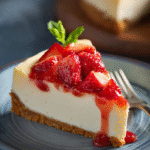
The Best New York Cheesecake Recipe
- Total Time: 1 hour 50 minutes
- Yield: 12 servings 1x
- Diet: Vegetarian
Description
This ultra-creamy, bakery-style New York cheesecake recipe is rich, indulgent, and totally foolproof. With a golden graham cracker crust and a smooth, tangy filling, it’s the ultimate make-ahead dessert for holidays, birthdays, or any celebration.
Ingredients
For the Crust:
- 2 cups graham cracker crumbs
- ½ cup unsalted butter, melted
- 2 tbsp sugar (optional)
- Pinch of salt
For the Filling:
- 4 (8 oz) blocks full-fat cream cheese, softened
- 1 cup granulated sugar
- 1 tsp vanilla extract
- 1 cup sour cream, room temperature
- 4 large eggs, room temperature
Instructions
1. Prepare the Crust
- Preheat oven to 325°F (163°C).
- In a bowl, combine graham cracker crumbs, melted butter, sugar, and salt.
- Press into the bottom of a 9-inch springform pan.
- Bake crust for 10 minutes. Let cool slightly.
2. Make the Filling
- Beat softened cream cheese until smooth (about 3 minutes).
- Add sugar and beat until creamy.
- Mix in vanilla and sour cream.
- Add eggs one at a time, mixing on low after each just until combined.
- Do not overmix.
3. Assemble and Bake
- Pour filling into cooled crust.
- Wrap the pan in foil and place it in a large roasting pan.
- Fill the outer pan with 1 inch of hot water (water bath).
- Bake at 325°F for 60–70 minutes. The edges should be set and the center slightly jiggly.
4. Cool and Chill
- Turn off oven and crack door open. Let cheesecake cool inside for 1 hour.
- Remove from oven and let sit at room temp for another 30–60 minutes.
- Chill uncovered in the fridge for at least 4 hours, preferably overnight.
5. Serve
- Run a knife around the edge before releasing the pan.
- Slice with a warm knife, wiping clean between cuts.
- Add toppings just before serving if desired.
Notes
- Let all ingredients come to room temperature for a smooth batter.
- Don’t skip the water bath—it prevents cracks.
- Cheesecake freezes well! Wrap slices in plastic wrap and foil.
- Best made a day in advance for flavor development.
- Prep Time: 40 minutes
- Cook Time: 1 hour 10 minutes
- Category: Dessert
- Method: Baking
- Cuisine: American
Nutrition
- Serving Size: 1 slice
- Calories: 450
- Sugar: 28g
- Sodium: 280mg
- Fat: 34g
- Saturated Fat: 20g
- Unsaturated Fat: 12g
- Trans Fat: 0g
- Carbohydrates: 32g
- Fiber: 0g
- Protein: 7g
- Cholesterol: 135mg


